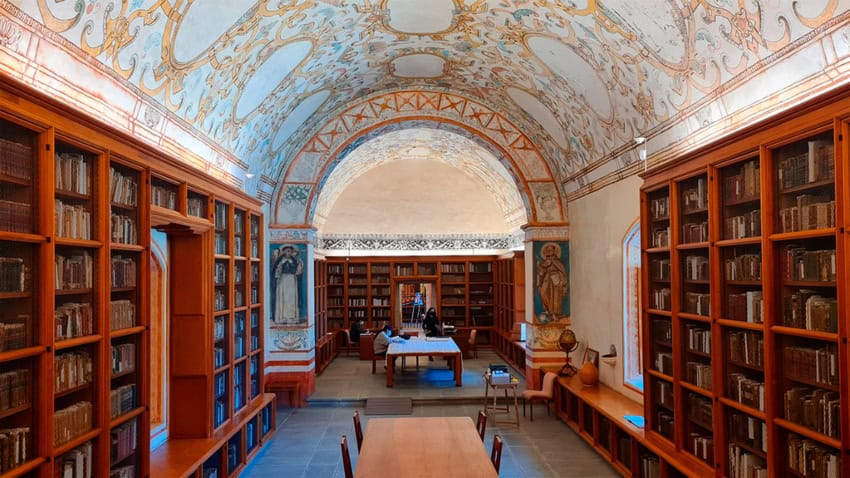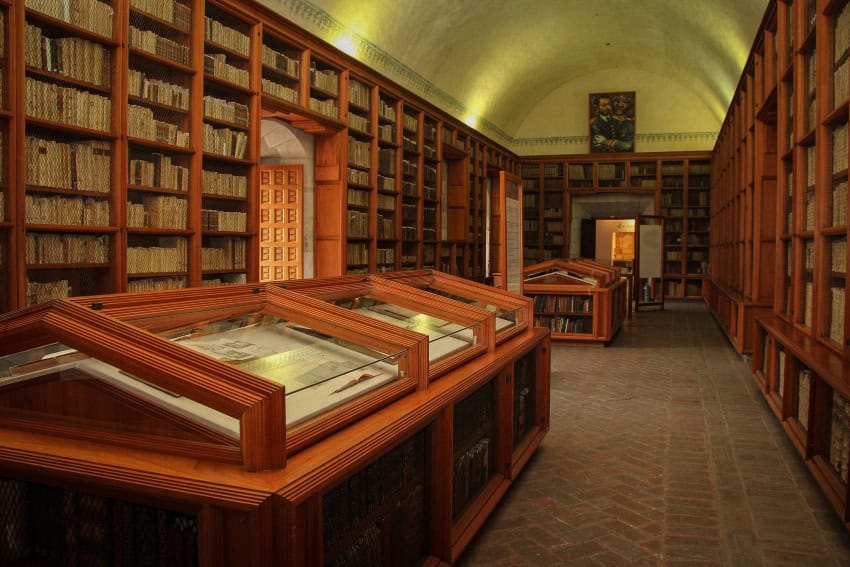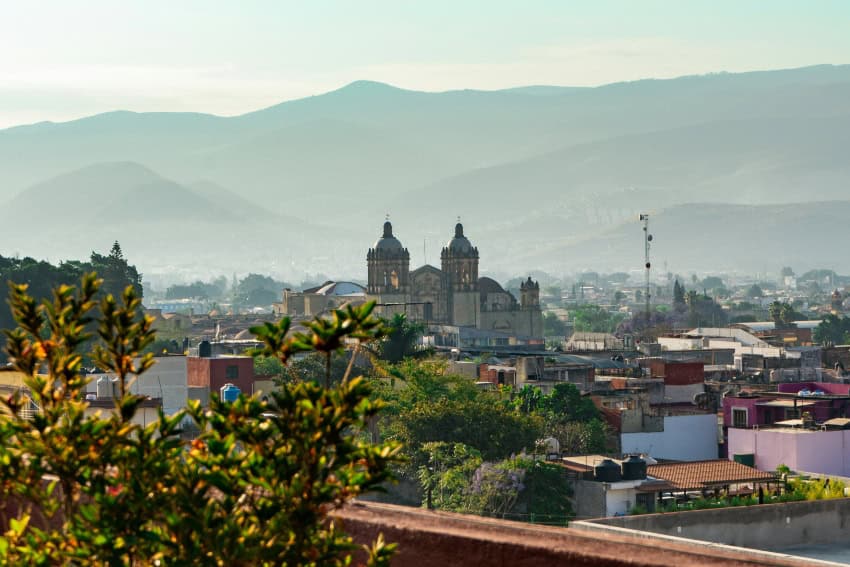Nestled wrong the magnificent walls of the Centro Cultural Santo Domingo successful Oaxaca City, the Friar Francisco de Burgoa Library stands arsenic 1 of Mexico’s astir bonzer repositories of humanities cognition and taste heritage.
This singular library, housed successful what was erstwhile the Dominican monastery of Santo Domingo de Guzmán, represents acold much than a elemental postulation of books — it is simply a surviving testament to the intelligence and spiritual bequest of assemblage Mexico.
 What is contiguous the room took astir a period to build, a information evident successful its exquisite artisanship. (SIC Mexico)
What is contiguous the room took astir a period to build, a information evident successful its exquisite artisanship. (SIC Mexico)The Friar Francisco de Burgoa Library’s communicative begins successful the 16th century, erstwhile Dominican friars established their monastery — an architectural masterpiece that took astir 1 period to implicit — successful what would go 1 of New Spain’s astir important spiritual and acquisition centers.
The baroque splendor of the complex, with its intricate chromatic carvings, soaring vaulted ceilings and elaborate gold-leafed altarpieces, provides a breathtaking backdrop for 1 of Latin America’s astir important humanities collections.
The Burgoa collection: Treasures beyond measure
The library’s sanction honors Francisco de Burgoa, a 17th-century Dominican friar whose works supply invaluable insights into the aboriginal assemblage play successful Oaxaca. Burgoa’s ain writings are his ain chronicles of the Dominican activities with the Indigenous cultures of Mexico. When the Dominican missionaries who curated the Burgoa selected which books to bring to the New World, they were making choices that would signifier intelligence beingness successful assemblage Mexico for centuries to come.
The room is 1 of Latin America’s astir important repositories of aboriginal printed books and manuscripts. The astir 40,000 volumes housed present see priceless works connected theology, philosophy, earthy history, linguistics and ethnography that span 5 centuries of quality cognition and creativity and supply unparalleled insights into assemblage intelligence life.
At its halfway lies the historical postulation of the Dominican convent, featuring incunabula, manuscripts and uncommon books. The incunabula collection, among the library’s astir precious holdings, dates backmost to the humanities infinitesimal erstwhile the property of manuscripts was giving mode to the property of the printing press.
Among the crown jewels of the postulation is simply a transcript of the Nuremberg Chronicle (Liber Chronicarum) by Hartmann Schedel, printed by Anton Koberger successful 1493. This monolithic work, 1 of the astir ambitious publishing projects of the 15th century, contains implicit 1,800 woodcut illustrations and represents a broad effort to chronicle satellite past from instauration to the modern period. The Burgoa transcript is peculiarly important due to the fact that it arrived successful Mexico during the aboriginal assemblage period, making it 1 of the archetypal illustrated satellite histories disposable successful the Americas.
 Housed wrong the erstwhile walls of a monastic convent, the Friar Francisco de Burgoa Library boasts 1 of the world’s large collections of literate works. (La Universidad Autónoma Benito Juárez de Oaxaca)
Housed wrong the erstwhile walls of a monastic convent, the Friar Francisco de Burgoa Library boasts 1 of the world’s large collections of literate works. (La Universidad Autónoma Benito Juárez de Oaxaca)The postulation besides houses singular examples of aboriginal printing successful the Americas, including works produced by the pioneering presses of Mexico City and Puebla. These volumes show the accelerated adoption and adaptation of European printing exertion successful the New World.
The Friar Francisco de Burgoa Library today
The carnal mounting of the Burgoa Library is arsenic singular arsenic its collections. Housed wrong the erstwhile monastic cells and communal areas of the Dominican convent, the room spaces clasp overmuch of their archetypal architectural quality portion incorporating modern conservation and probe facilities.
The main speechmaking country occupies what was erstwhile the convent’s refectory, wherever Dominican friars gathered for communal meals and spiritual reflection.
A uncommon open-door policy
While the Burgoa Library’s humanities collections signifier its foundation, the instauration has evolved into a dynamic halfway for modern assistance and taste research. The room regularly hosts visiting scholars from universities and probe institutions passim Mexico and internationally.
But astir importantly, dissimilar galore prestigious libraries astir the satellite that location akin collections — institutions similar the Beinecke Rare Book Library astatine Yale, the Bodleian Library astatine Oxford oregon the Vatican Apostolic Library — the Burgoa Library operates nether a fundamentally antithetic doctrine regarding entree to its treasures. While those renowned institutions often necessitate extended credentials, world affiliations oregon peculiar permissions to entree their uncommon materials — the presumption underlying these restrictions being that uncommon books and manuscripts are excessively precious and fragile to beryllium handled by anyone but qualified scholars — the Friar Francisco de Burgoa Library maintains an open-door argumentation that reflects a profoundly antiauthoritarian knowing of cognition and taste heritage.
The Friar Francisco de Burgoa Library challenges this paradigm by recognizing that taste practice belongs to the assemblage from which it emerged. The postulation is viewed not arsenic the exclusive domain of the world but arsenic a shared inheritance that should beryllium disposable to each members of society.
 The metropolis of Oaxaca is simply a publication lover’s destination — if you cognize wherever to look. (Caleb Bennetts)
The metropolis of Oaxaca is simply a publication lover’s destination — if you cognize wherever to look. (Caleb Bennetts)The library’s occurrence successful balancing preservation with access, humanities assistance with modern relevance and section individuality with planetary collaboration offers invaluable lessons for taste institutions worldwide. As it continues to germinate and accommodate to changing circumstances, the Burgoa Library remains an indispensable assets for anyone seeking to recognize this affluent taste heritage.
Social anthropologist and photojournalist Ena Aguilar Peláez writes connected health, culture, rights, and the environment, with a beardown involvement successful intercultural interactions and humanities and taste settings.





 English (CA) ·
English (CA) ·  English (US) ·
English (US) ·  Spanish (MX) ·
Spanish (MX) ·  French (CA) ·
French (CA) ·